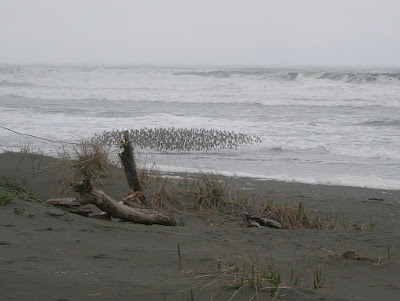Friday afternoon we heard an alert that American Avocets (one of my favorite birds since our recent California trip where we saw quite a few, but rarely seen in eastern Minnesota) had been seen at
Lake Byllesby. Since it was a beautiful warm day but rain was predicted for later, we left work a bit early, grabbed our birding gear, and headed over to this reservoir and county park on the border between Dakota and Goodhue counties.

We stopped first by the Hwy 56 bridge at the county line, where the Cannon River flows into the west end of the lake. This is a good area for shorebirds, as the water is shallow and there are mudflats and sandbars from which such birds can forage. As we looked east, our eyes were focused on an area beyond the tree in the foreground, where we could see shorebirds ("peeps") aplenty. Suddenly Dave gasped. He had finally noticed, at the top of the tree we'd been looking past, a bold, large spot of black and white that could only mean an
osprey. If you click on the photo above, you'll be able to see it as we first noticed it.

We got the spotting scope pointed in the right direction (cars whizzing by at 55 mph just a few feet behind our backs), and I was able to get some decent-enough shots through the scope to capture the magnificence of this beautiful bird of prey.

Here in southeastern Minnesota we are at the edge of the osprey's summer breeding area and would generally see them in migration rather than nesting. A few years ago we drove up to the football field at Irondale High School in New Brighton, where
ospreys were nesting on a lightpole. That was the first time I had seen ospreys, and they made quite an impression on me.

Look at the heft of the beak of this raptor, which eats fish almost exclusively. The wingspan can range from 59 to 71 inches (150-180 cm). It is an enormous bird, and its coloring is so unmistakeable. In flight, seen from below, both black and white show on the wings, which are held in a crooked, slightly arched position.
After a few minutes this osprey launched itself from the tree and disappeared toward the main body of the lake. We went on to see a lot of shorebirds on this outing, though no avocets, but this was an unexpected and fantastic start to the expedition.
Addendum: For some wonderful shots of an osprey fishing, visit the
Birding in Maine blog.
 This bold or at least inquiring rabbit appeared on our deck on Saturday. Perhaps it has done so before when we were not at home. We were surprised it would come so close to the house. It didn't seem to notice me inside, taking several photos of it through the sliding door, even though I forgot to turn off the flash the first time.
This bold or at least inquiring rabbit appeared on our deck on Saturday. Perhaps it has done so before when we were not at home. We were surprised it would come so close to the house. It didn't seem to notice me inside, taking several photos of it through the sliding door, even though I forgot to turn off the flash the first time. After a bit it hopped away -- lippety, lippety, not very fast* -- and then it was joined by another!
After a bit it hopped away -- lippety, lippety, not very fast* -- and then it was joined by another! *Recognize the literary reference?
*Recognize the literary reference?











 We got the spotting scope pointed in the right direction (cars whizzing by at 55 mph just a few feet behind our backs), and I was able to get some decent-enough shots through the scope to capture the magnificence of this beautiful bird of prey.
We got the spotting scope pointed in the right direction (cars whizzing by at 55 mph just a few feet behind our backs), and I was able to get some decent-enough shots through the scope to capture the magnificence of this beautiful bird of prey.

























